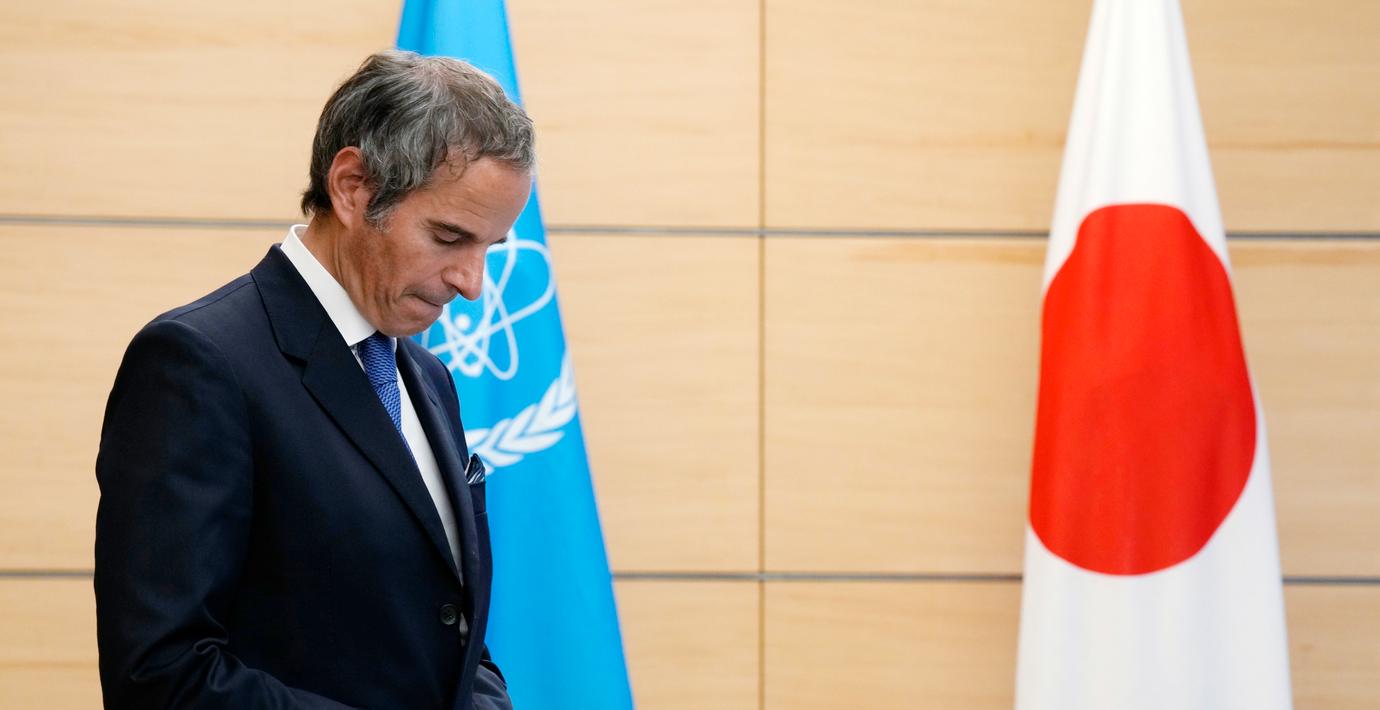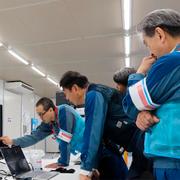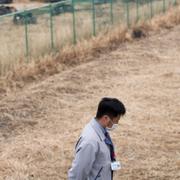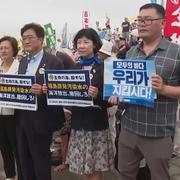
FN:s atomenergichef vill lugna Fukushimas invånare
Rafael Grossi, chef för FN:s atomenergiorgan IAEA, har försökt försäkra invånarna i japanska Fukushima om att planen att släppa ut radioaktivt vatten i havet är säker.
– Detta är, vilket IAEA intygar, den allmänna praxis som har överenskommits och följs på många, många platser över hela världen, säger han på ett möte med lokala företrädare enligt flera nyhetsbyråer.
Det sker sedan IAEA under tisdagen gav slutgiltigt klartecken för att släppa ut kylvatten från de kärnkraftsreaktorer som förstördes i tsunami- och jordbävningskatastrofen 2011.
bakgrund
Kärnkraftskatastrofen i Fukushima
Wikipedia (en)
On 11 March 2011, a nuclear accident occurred at the Fukushima Daiichi Nuclear Power Plant in Ōkuma, Fukushima, Japan. The proximate cause of the disaster was the Tōhoku earthquake and tsunami, which remains the most powerful earthquake ever recorded in Japan. The earthquake triggered a powerful tsunami, with 13- to 14-meter-high waves damaging the nuclear power plant's emergency diesel generators, leading to a loss of electric power. The result was the most severe nuclear accident since the Chernobyl disaster in 1986, classified as level seven on the International Nuclear Event Scale (INES) after initially being classified as level five, and thus joining Chernobyl as the only other accident to receive such classification. While the 1957 explosion at the Mayak facility was the second worst by radioactivity released, the INES ranks incidents by impact on population, so Chernobyl (335,000 people evacuated) and Fukushima (154,000 evacuated) rank higher than the 10,000 evacuated from the Mayak site in the rural southern Urals.
The accident was triggered by the Tōhoku earthquake and tsunami, which occurred in the Pacific Ocean about 72 kilometres (45 mi) east of the Japanese mainland at 14:46 JST on Friday, 11 March 2011. On detecting the earthquake, the active reactors automatically shut down their normal power-generating fission reactions. Because of these shutdowns and other electrical grid supply problems, the reactors' electricity supply failed, and their emergency diesel generators automatically started. Critically, these were required to provide electrical power to the pumps that circulated coolant through the reactors' cores. This continued circulation was vital to remove residual decay heat, which continues to be produced after fission has ceased. However, the earthquake had also generated a tsunami 14 metres (46 ft) high that arrived shortly afterwards, swept over the plant's seawall, and then flooded the lower parts of the reactor buildings at units 1–4. This flooding caused the failure of the emergency generators and loss of power to the circulating pumps. The resulting loss of reactor core cooling led to three nuclear meltdowns, three hydrogen explosions, and the release of radioactive contamination in Units 1, 2 and 3 between 12 and 15 March. The spent fuel pool of the previously shut-down Reactor 4 increased in temperature on 15 March due to decay heat from newly added spent fuel rods, but did not boil down sufficiently to expose the fuel.In the days after the accident, radiation released into the atmosphere forced the government to declare an ever-larger evacuation zone around the plant, culminating in an evacuation zone with a 20 kilometres (12 mi) radius. All told, some 110,000 residents were evacuated from the communities surrounding the plant due to the rising off-site levels of ambient ionizing radiation caused by airborne radioactive contamination from the damaged reactors.Large amounts of water contaminated with radioactive isotopes were released into the Pacific Ocean during and after the disaster. Michio Aoyama, a professor of radioisotope geoscience at the Institute of Environmental Radioactivity, has estimated that 18,000 terabecquerel (TBq) of radioactive caesium-137 were released into the Pacific during the accident, and in 2013, 30 gigabecquerel (GBq) of caesium-137 were still flowing into the ocean every day. The plant's operator has since built new walls along the coast and has created a 1.5 kilometres (0.93 mi) long "ice wall" of frozen earth to stop the flow of contaminated water.Tokyo Electric Power Company (TEPCO) is going to remove the remaining nuclear fuel material from the plants. TEPCO completed the removal of 1535 fuel assemblies from the Unit 4 spent fuel pool in December 2014 and 566 fuel assemblies from the Unit 3 spent fuel pool in February 2021. TEPCO plans to remove all fuel rods from the spent fuel pools of Units 1, 2, 5, and 6 by 2031 and to remove the remaining molten fuel debris from the reactor containments of Units 1, 2, and 3 by 2040 or 2050. An ongoing intensive cleanup program to both decontaminate affected areas and decommission the plant will take 30 to 40 years from the disaster, plant management estimated.While there has been ongoing controversy over the health effects of the disaster, a 2014 report by the United Nations Scientific Committee on the Effects of Atomic Radiation (UNSCEAR) and World Health Organization projected no increase in miscarriages, stillbirths or physical and mental disorders in babies born after the accident. A follow-up report released in 2022, UNSCEAR 2020/2021, broadly confirms the major findings and conclusions of the original report, UNSCEAR 2013. Evacuation and sheltering to protect the public significantly reduced potential radiation exposures by a factor of 10, according to UNSCEAR. UNSCEAR also reported that the evacuations themselves had repercussions for the people involved, including a number of evacuation-related deaths and a subsequent impact on mental and social well-being (for example, because evacuees were separated from their homes and familiar surroundings, and many lost their livelihoods).On 5 July 2012, the National Diet of Japan Fukushima Nuclear Accident Independent Investigation Commission (NAIIC) found that the causes of the accident had been foreseeable, and that the plant operator, Tokyo Electric Power Company (TEPCO), had failed to meet basic safety requirements such as risk assessment, preparing for containing collateral damage, and developing evacuation plans. At a meeting in Vienna three months after the disaster, the International Atomic Energy Agency faulted lax oversight by the Japanese Ministry of Economy, Trade and Industry, saying the ministry faced an inherent conflict of interest as the government agency in charge of both regulating and promoting the nuclear power industry. On 12 October 2012, TEPCO admitted for the first time that it had failed to take necessary measures for fear of inviting lawsuits or protests against its nuclear plants.
Omni är politiskt obundna och oberoende. Vi strävar efter att ge fler perspektiv på nyheterna. Har du frågor eller synpunkter kring vår rapportering? Kontakta redaktionen



